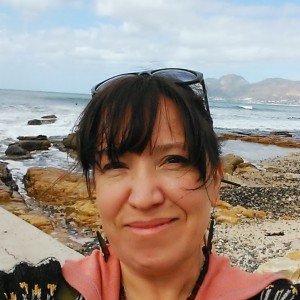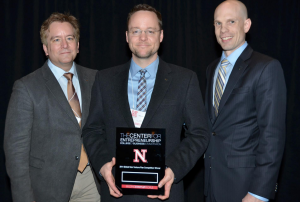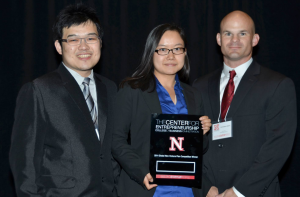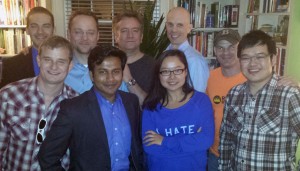We’re excited to announce that on February 5, 2015, our very own Flipped Health won the 2015 Texas Venture Labs Investment Competition!
Read on to find out what set Flipped Health’s pitch apart from the other teams to come out as champions with a $5,000 check…

On the 32nd anniversary of TVLIC, more than 20 startup companies pitched their business plans to a panel of some of the most notable venture capital investors and entrepreneurs in the industry, including partners from Austin Technology Incubator (ATI), Bunker Incubator, and PuraVida Ventures.
So, what set the winning team apart?
They told a story.
It was more than a presentation. It was an engaging story that followed a sequence. The most captivating stories always start off with a carefully crafted beginning – and this story was no exception!
Think you know what your beginning slide should look like? Think again. In order to reel the investors in, the very first slide began with the story of The Broken Vaccine Cold Chain. Contrast that title with the title of the original first slide they began with, The Dry Vaccine Process – does this get you excited about team Flipped Health and their solution?

This is the traditional beginning slide that most teams start off with, where the first words out of a speaker’s mouth are “Hello everyone, we are Team X…” effectively losing the audience, and likely, their chances at winning a chunk of cash.
But Flipped Health isn’t your average team, and neither is the solution they were trying to sell – after an overhaul by yours truly, the first slide in the deck started the story off with a bang:

We coached them to jump in with a relatable anecdote, emphasizing the “what is” to describe the current landscape with a personal example that all of the judges could identify with. After 30 gripping seconds, the speaker emphatically reinforced what the audience was now beginning to understand: “This is a scary and expensive problem.” After setting the baseline of “what is”, they moved on to describe “What could be” – their solution.

AriVax, a drug delivery platform that improves vaccine stability, reduces vaccine wastage, and enables delivery to emerging markets that can’t meet temperature-controlled supply chain (cold chain) requirements.
It was jargon-free.
One of the biggest mistakes made by high-tech teams is acting like they are presenting to other people who are deeply embedded in their respective industry – not investors who probably don’t know the first thing about vaccines and the issues surrounding the cold chain process. The visuals didn’t just get a makeover – the words did, too. Moral of the story? Lose the jargon, NOW.
They connected to the audience with a metaphor.
Here’s where the tried and true STAR method, comes in: drive a big idea home by giving the audience members Something They’ll Always Remember. We came up with a way to communicate the ease of the AriVax solution that shifted the momentum of the pitch and got a laugh from all of the investors… AriVax is easy as Kool-Aid!

Seamless transitions.
It may seem small, but every single speaker clearly announced topic shifts throughout the presentation. This served to make the overall pitch absolutely seamless.
By taking care to verbalize the movement to the next major part of the story, “I will now hand it off to Jason, who will explain the current need in the global market…”, Cheryl ensured that the judges would have no questions about where one topic began and ended.
Confident answers to every question.
With a total of 15-20 questions asked by investors, the presentation was comparable to an investigation. Investors probed into areas like cost breakdown, use case validation, alternative solutions to the one they were proposing, and valuation; at every turn, a team member was prepared with an analytical + emotive answer.
Straightforward slides.
We can’t stress how important it is to have clean, aesthetically appealing slides that communicate the key points – and only the key points. Flipped Health’s slides were strategically placed, easy to follow, and served to enhance the overall message.
All of the above strategies helped Flipped Health come out of the Texas Venture Labs Investment Competition with the 1st place spot, an automatic entry to Global TVLIC, a 1 year launch package at Austin Technology Incubator, and this giant check:

Congratulations again, Flipped Health!
The above points are some of the key aspects of Flipped Health’s pitch that propelled them to first place. We had a blast getting to coach this stellar team to success, and we hope the points we’ve described here will help you and your team achieve the results you want to see. Remember, it’s all about selling yourself AND your ideas, and you can count on us to keep you up-to-date with the latest communication insights and analysis on modern pitching strategies.
Find out how The Pitch Academy’s coaches can customize our innovative approach to get your ideas sold and your team funded – contact Melissa today!


 But not if John Joyoprayitno, MSTC ’13, has his way. The co-founder and chief operating officer of Austin-based Alafair Biosciences is working to commercialize a natural membrane that could minimize adhesions by acting as an “internal Band-Aid” on surgical wounds.
But not if John Joyoprayitno, MSTC ’13, has his way. The co-founder and chief operating officer of Austin-based Alafair Biosciences is working to commercialize a natural membrane that could minimize adhesions by acting as an “internal Band-Aid” on surgical wounds.

